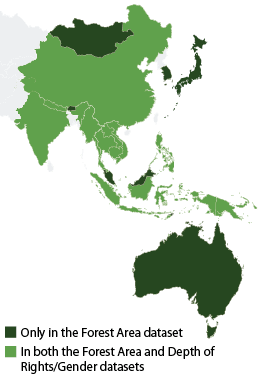Explore data from Asia.
RRI’s Forest Tenure data tracks forest area via 4 tenure categories, which are based on the rightsholder and strength of their rights under national law. This employs a bundle of rights approach that links RRI’s qualitative and quantitative data. The database also tracks the statutory distribution of Forest Tenure from 2002 to 2017.
Use the key to see which data is available for each of the 18 examined countries in Asia.
- Australia
- Bhutan
- Cambodia
- China
- India
- Indonesia
- Japan
- Korea, Republic of
- Lao PDR
- Malaysia
- Mongolia
- Myanmar
- Nepal
- Papua New Guinea
- Philippines
- Thailand
- Timor-Leste
- Viet Nam

Key Findings About Women’s Rights to Community Forests in Asia
Several Asian countries analyzed in 2024 actively diminished community women’s forest rights through regressive legal reforms, and protections for collective Free, Prior and Informed Consent (FPIC) rights remain the weakest of the three analyzed regions.
As of 2024, Asia leads among the regions analyzed in the proportion of adequate protections for women across 4 of the 5 CBTR-specific indicators (Membership, Voting, Inheritance, and Dispute Resolution), with the greatest degree of proportional growth for adequate protections for Membership and Dispute Resolution of any region between 2016 and 2024.
However, Asia is not the leader in relation to the overarching rights of women. Asia remains the only region analyzed where all countries do not adequately recognize women’s Constitutional Equal Protection by ensuring gender-based discrimination is either prohibited or gender equality is specifically guaranteed. Indonesia is the only country out of the 35 assessed that does not adequately recognize Constitutional Equal Protection; its constitution only contains a non-discrimination provision that does not specify gender.
RRI’s Depth of Rights analysis assesses the status and strength of Indigenous Peoples’ and local communities’ statutory forest tenure rights across 11 countries in Asia.
The legal frameworks assessed, called community-based tenure regimes (CBTRs), are defined as distinguishable sets of national, state-issued laws and regulations governing “all situations under which the right to own or manage terrestrial natural resources is held at the community level.”
- 2016
- 2024
Sources: RRI. 2016. Depth of Rigths Database.
Sources: RRI. 2024. Depth of Rigths Database.
RRI assesses two contextual indicators that provide nuance regarding the rights included in the bundle of rights: 1) Free, Prior and Informed Consent (FPIC), and 2) the right to use resources or areas for cultural and/or religious purposes.
Sources: RRI. 2024. Depth of Rights Database.
Sources: RRI. 2024. Depth of Rights Database.
RRI’s Gender Database builds on the Bundle of Rights to assess the extent to which legal frameworks, or CBTRs, recognize Indigenous and local community women’s specific rights to community forests, and whether those states are meeting their obligations under national and international laws.
Learn more about RRI’s Gender Methodology.
- 2016
- 2024
RRI’s Forest Tenure Database tracks the statutory distribution of Forest Tenure going back to 2002. Under RRI’s typology, all forest area in the countries studied are classified as either: (1) Government Administered; (2) Designated for Indigenous Peoples, Afro-descendant Peoples, and local communities; (3) Owned by Indigenous Peoples, Afro-descendant Peoples, and local communities; or (4) Privately Owned by Individuals and Firms. To read more about the methodology underpinning this classification, click here.
Source: RRI. 2018. At a Crossroads: Trends in Recognition of Community-Based Forest Tenure from 2002-2017.
Explore country-level data on the distribution of Forest Tenure over time in Mha. Click on the country name to learn more about the legal frameworks recognizing community-based tenure, including the rights of Indigenous, Afro-descendant, and community women.
Country
Government Administered
2002 2017Designated for Indigenous Peoples, Afro-descendant Peoples, and Local Communities
2002 2017Owned by Indigenous Peoples, Afro-descendant Peoples, and Local Communities
2002 2017Privately Owned by Individuals and Firms
2002 2017Highlighting in gray indicates Complete Case Countries.
Dashes (-) denote situations in which the tenure category in question is not legally possible under national law.
n.d. = No Data
Source: RRI. 2018. At a Crossroads: Trends in Recognition of Community-Based Forest Tenure from 2002-2017.




